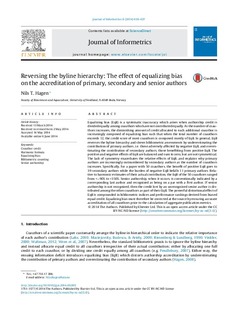Reversing the byline hierarchy : The effect of equalizing bias on the accreditation of primary, secondary and senior authors
Journal article, Peer reviewed

Åpne
Permanent lenke
http://hdl.handle.net/11250/274036Utgivelsesdato
2014Metadata
Vis full innførselSamlinger
Originalversjon
Hagen, N.T. (2014). Reversing the byline hierarchy: The effect of equalizing bias on the accreditation of primary, secondary and senior authors. Journal of Informetrics, 8(3), 618-627. doi: 10.1016/j.joi.2014.05.003Sammendrag
Equalizing bias (EqB) is a systematic inaccuracy which arises when authorship credit is divided equally among coauthors who have not contributed equally. As the number of coauthors increases, the diminishing amount of credit allocated to each additional coauthor is increasingly composed of equalizing bias such that when the total number of coauthors exceeds 12, the credit score of most coauthors is composed mostly of EqB. In general, EqB reverses the byline hierarchy and skews bibliometric assessments by underestimating the contribution of primary authors, i.e. those adversely affected by negative EqB, and overestimating the contribution of secondary authors, those benefitting from positive EqB. The positive and negative effects of EqB are balanced and sum to zero, but are not symmetrical. The lack of symmetry exacerbates the relative effects of EqB, and explains why primary authors are increasingly outnumbered by secondary authors as the number of coauthors increases. Specifically, for a paper with 50 coauthors, the benefit of positive EqB goes to 39 secondary authors while the burden of negative EqB befalls 11 primary authors. Relative to harmonic estimates of their actual contribution, the EqB of the 50 coauthors ranged from <−90% to >350%. Senior authorship, when it occurs, is conventionally indicated by a corresponding last author and recognized as being on a par with a first author. If senior authorship is not recognized, then the credit lost by an unrecognized senior author is distributed among the other coauthors as part of their EqB. The powerful distortional effect of EqB is compounded in bibliometric indices and performance rankings derived from biased equal credit. Equalizing bias must therefore be corrected at the source by ensuring accurate accreditation of all coauthors prior to the calculation of aggregate publication metrics.
